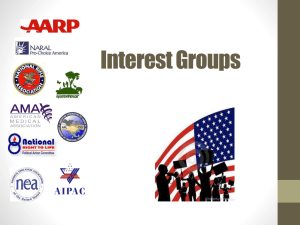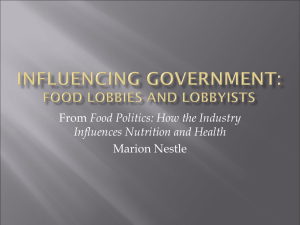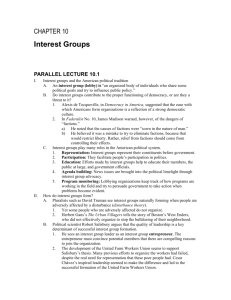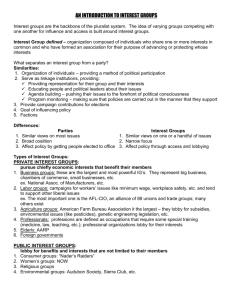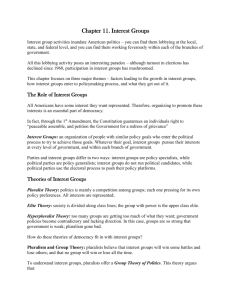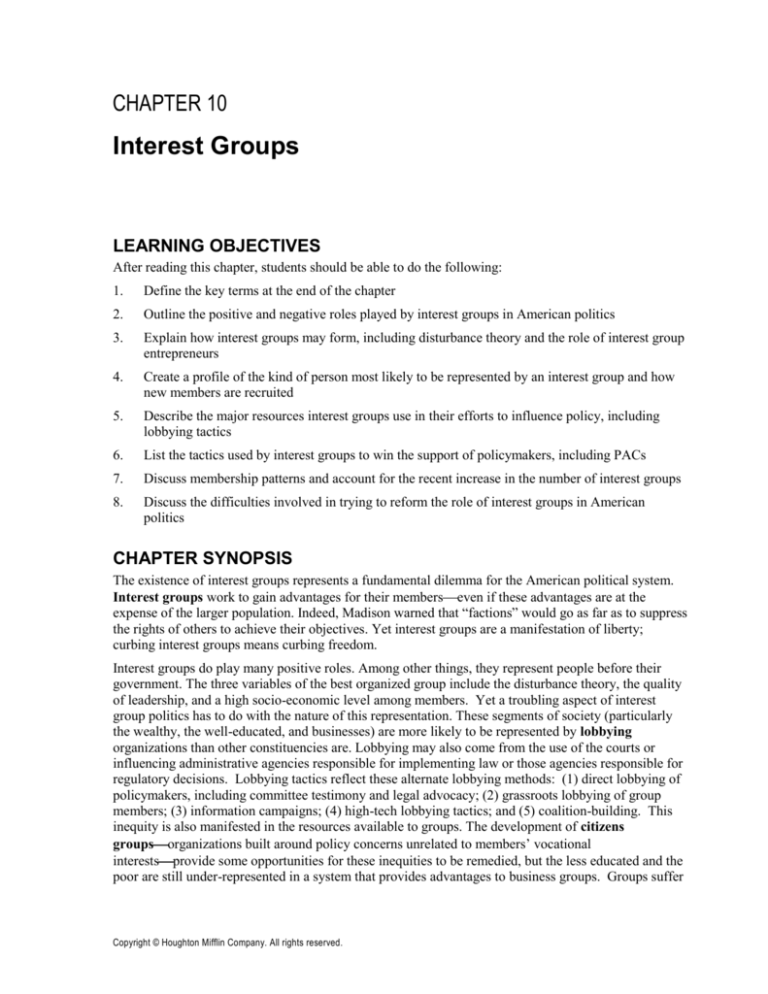
CHAPTER 10
Interest Groups
LEARNING OBJECTIVES
After reading this chapter, students should be able to do the following:
1.
Define the key terms at the end of the chapter
2.
Outline the positive and negative roles played by interest groups in American politics
3.
Explain how interest groups may form, including disturbance theory and the role of interest group
entrepreneurs
4.
Create a profile of the kind of person most likely to be represented by an interest group and how
new members are recruited
5.
Describe the major resources interest groups use in their efforts to influence policy, including
lobbying tactics
6.
List the tactics used by interest groups to win the support of policymakers, including PACs
7.
Discuss membership patterns and account for the recent increase in the number of interest groups
8.
Discuss the difficulties involved in trying to reform the role of interest groups in American
politics
CHAPTER SYNOPSIS
The existence of interest groups represents a fundamental dilemma for the American political system.
Interest groups work to gain advantages for their memberseven if these advantages are at the
expense of the larger population. Indeed, Madison warned that “factions” would go as far as to suppress
the rights of others to achieve their objectives. Yet interest groups are a manifestation of liberty;
curbing interest groups means curbing freedom.
Interest groups do play many positive roles. Among other things, they represent people before their
government. The three variables of the best organized group include the disturbance theory, the quality
of leadership, and a high socio-economic level among members. Yet a troubling aspect of interest
group politics has to do with the nature of this representation. These segments of society (particularly
the wealthy, the well-educated, and businesses) are more likely to be represented by lobbying
organizations than other constituencies are. Lobbying may also come from the use of the courts or
influencing administrative agencies responsible for implementing law or those agencies responsible for
regulatory decisions. Lobbying tactics reflect these alternate lobbying methods: (1) direct lobbying of
policymakers, including committee testimony and legal advocacy; (2) grassroots lobbying of group
members; (3) information campaigns; (4) high-tech lobbying tactics; and (5) coalition-building. This
inequity is also manifested in the resources available to groups. The development of citizens
groupsorganizations built around policy concerns unrelated to members’ vocational
interestsprovide some opportunities for these inequities to be remedied, but the less educated and the
poor are still under-represented in a system that provides advantages to business groups. Groups suffer
Copyright © Houghton Mifflin Company. All rights reserved.
110
Chapter 10: Interest Groups
from free-riders, as well, who gain the residual benefits of membership without becoming formal
members.
In recent years we have observed an upsurge in the number of interest groups. The most troubling
aspect of that growth is the increasingly significant role political action committees, or PACs, play in
financing congressional elections. The greatest portion of PAC contributions comes from corporate
PACs. Critics charge that PACs gain undue advantage from the access they gain with contributions.
They argue that PACs exacerbate the inequities in American society. Defenders respond that PACs are
a way in which people can participate in politics. Moreover, shouldn’t people have the freedom to join
together with other like-minded Americans to promote the candidates they believe in?
PARALLEL LECTURE 10.1
I.
II.
Interest groups and the American political tradition
A. Interest group: an organized body of individuals that seeks to influence public policy.
1. Also called a lobby
2. Interest group representatives are called lobbyists.
B. Interest groups: good or evil?
1. Alexis de Tocqueville
a) Wrote Democracy in America
b) Suggested that the ease with which Americans form organizations is a reflection
of a strong democratic culture
2. Federalist No. 10 warned of the dangers of “factions.”
a) Madison noted that the causes of factions were “sown in the nature of man.”
b) Trying to eliminate factions would restrict liberty.
c) Relief from factions should come from controlling their effects.
C. The roles of interest groups
1. Representation: represent their constituents before government.
2. Participation: facilitate and stimulate people’s participation in politics.
3. Education: educate their members, the public at large, and government officials.
4. Agenda building: the process by which new issues are brought into the political
limelight.
5. Program monitoring: keeping track of government programs, usually by interest
groups.
How do interest groups form?
A. Disturbance theory: interest groups naturally forming when people are adversely affected by
a disturbance.
1. Yet some people do not organize.
2. Boston’s West Enders did not effectively organize to stop the bulldozing of their
neighborhood.
B. Interest group entrepreneurs
1. Interest group entrepreneur: an interest group organizer or leader.
a) Must have something attractive to “market” to convince people to join
b) Members must be persuaded that benefits of joining outweigh the costs.
2. The case of Cesar Chavez and the United Farm Workers Union supports this theory.
C. Who is being organized?
1. Poor, uneducated or undereducated, and politically inexperienced people are the most
difficult to organize.
2. People with money, education, and political experience are confident their actions will
make a difference.
Copyright © Houghton Mifflin Company. All rights reserved.
Chapter 10: Interest Groups
3.
111
Factors affecting group organization
a) Adverse change can contribute to people’s awareness that they need
representation.
b) Quality of leadership is critical.
c) Higher socio-economic level of potential members makes them more likely to
join.
d) Interest groups may be established by institutions, and thus not need “members.”
III. Interest group resources
A. Membership
1. A large, politically active membership is a valuable resource.
2. Members give an organization both political muscle and financial resources.
3. Maintaining membership
a) Communications tools—newsletters and e-mails—tell members the group is
advocating for their interests.
b) Business, professional, and trade associations have an easier time holding onto
members than do citizen groups.
4. Attracting new members
a) Citizen groups must rely largely on ideological appeals.
(1) Competition for members is intense.
(2) Issues blow hot and cold.
b) Direct mail: letters sent to a selected audience to promote the organization and
appeal for contributions.
(1) Audience must be carefully targeted.
(2) Drawbacks: expensive, low rate of return.
c) The Internet allows groups to build membership and new groups to form.
5. The free-rider problem: the situation in which people benefit from the activities of an
organization (such as an interest group) but do not contribute to those activities.
a) Increases the difficulty of attracting paying members
b) People do join groups anyway:
(1) People feel a responsibility or sense of concern.
(2) Many organizations offer other membership benefits.
B. Lobbyists
1. Can be either full-time employees of the organization or hired from law firms or public
relations firms
a) Valued for their experience and knowledge of how government operates
b) Often have served in legislative or executive branch or held a political party post
c) Many lobbyists have law degrees
2. Lobbyists as fundraisers
a) Last election cycle, lobbyists contributed $25 million to congressional
candidates.
b) Lobbyists also raised money for legislators.
3. The typical interaction between a lobbyist and a policymaker is the transmission of
information.
4. Lobbyist is trying to convince the policymaker that their data are accurate and their
goals should be pursued.
C. PACs and 527s
1. Political action committee (PAC): an organization that pools campaign contributions
from group members and donates those funds to candidates for political office.
a) PACs can give as much as five thousand dollars to a candidate for Congress in
each election.
Copyright © Houghton Mifflin Company. All rights reserved.
112
Chapter 10: Interest Groups
b) There were more than four thousand PACs in 2006.
Two types of PACs have shown the greatest growth in numbers.
a) Corporate PACs
b) Nonconnected PACs (ideological PACs formed solely for channeling funds)
3. Most PACs are small and give less than fifty thousand dollars in total during a two
year election cycle.
4. About fifty PACs contributed at least $1 million during the last election cycle.
5. Primary goal of contributions is generally to gain access to incumbents
a) Political scientists have been unable to document a consistent link between
campaign donations and congressional voting patterns.
b) PAC donations do seem to influence congressional committee actions.
6. 527 groups: can take a stand on an issue, but cannot directly contribute to candidates
a) Cannot explicitly endorse a candidate or explicitly ask voters to vote against a
candidate
b) Can accept contributions of unlimited size
c) Can indirectly criticize candidates by emphasizing an issue that illuminates the
difference between candidates
7. American public is suspicious of PACs and 527s
IV. Lobbying tactics
A. Lobbying goes beyond the legislative branch.
1. Groups may also go to administrative agencies and courts
2. Lobbying may continue through the regulatory process
B. Direct lobbying: attempts to influence a legislator’s vote through personal contact
1. Present information about ways a policy will benefit constituents
2. Try to help policymakers do their job
3. Reshape the definition of the issue toward their desired end
4. May also testify before committees
5. Organizations may also engage in legal advocacy
C. Grassroots lobbying: lobbying activities performed by rank-and-file interest group
members and would-be members.
1. Most common tactic is letter writing
2. If government is unresponsive, group may resort to political protest
a) Designed to attract media attention
b) Difficult to sustain the anger and energy of group supporters
D. Information campaign: an organized effort to gain public backing by bringing the group’s
views to public attention.
1. Public ignorance and apathy are as much a problem as competing interest groups
2. Public relations may involve advertising in newspapers, sending speakers to meetings,
disseminating pamphlets or fact sheets, or establishing websites.
E. High-Tech lobbying
1. Lobbies use technologies like e-mail, polling, and the World Wide Web to expand their
reach.
2. Has sped up the political process
3. Reduces the cost of communicating with members and potential members
4. Has become increasingly difficult to gain a competitive edge because technology is
available to all sides
F. Coalition building: the banding together of several interest groups for the purpose of
lobbying.
1. Most coalitions exist only for the purpose of lobbying on a single issue.
2. Coalitions often extend beyond organizations with similar constituencies and outlooks.
2.
Copyright © Houghton Mifflin Company. All rights reserved.
Chapter 10: Interest Groups
V.
113
Is the system biased?
A. The issue of fairness in policymaking in a pluralist system
1. All significant interests in the population should be adequately represented.
2. Government should listen to the views of all major interests.
B. Membership bias
1. Some sectors of society are much better represented than others.
2. Profound bias in favor of those who are well-off financially
C. Citizen groups: lobbying organizations built around policy concerns unrelated to members’
vocational interests.
1. Poverty groups (e.g., The Center for Budget and Policy Priorities, the Children’s
Defense Fund)
a) Gain financial support from philanthropic foundations, government grants,
corporations, and wealthy individuals
b) Poor are underrepresented, but the situation is not as bad as membership pattern
suggest
2. Other types of citizen groups: environmental protection, consumer protection, family
values, good government, equality for various groups
a) Are particularly affected by free-rider problem
b) Have grown in both number and membership
c) Receive substantial news coverage
D. Business mobilization
1. Number of business lobbies increased in the 1970s and 1980s
a) Partly a reaction to success of liberal citizen groups
b) Also a response to expanded scope of national government
2. Almost two thirds of all organizations lobbying on all issues are business related.
E. Reform
1. Difficult to put limits on interest groups without limiting fundamental freedoms
2. PACs are particularly problematic.
a) PAC donations give donors better access to members of Congress.
b) BCRA bans PACs from donating “soft money” to the national parties.
c) 527s present new challenges.
FOCUS LECTURE 10.1
Interest Groups and Organizations
We should keep in mind that when we talk about an interest group, we are not talking about people who
hold similar views. Rather, an interest group is an organization that represents people who hold similar
views. In this lecture we examine patterns of organizational behavior common to interest groups.
I.
Organizational maintenance
A. The first consequence of people’s banding together to form an interest group is that they
have to find a way of maintaining that organization. Like the new baby in the family, it has
to be fed regularly. Its diet is money.
1. Money is needed to pay for the organization’s office, the salaries for its employees,
and standard overhead expenses ranging from the phone bill to paper clips.
2. A significant portion of that money must be used to search for more money. That is,
people must be hired and postage and other expenses paid for so that the organization
can find new members or other sources of funds.
Copyright © Houghton Mifflin Company. All rights reserved.
114
Chapter 10: Interest Groups
B.
II.
Different kinds of interest groups face different challenges in attracting members.
1. Labor unions often have closed-shop contracts, so any new worker is obligated to join.
To run a closed shop, however, unions must first win a representation election, which
happens less and less frequently. Furthermore, the change from an industrial economy
to a service economy in the United States has made it more difficult for unions to find
new members.
2. Trade associations must effectively market the services they offer to members.
Political advocacy is usually only a small part of what they do. What business
advantages will a new member get by joining?
3. Citizen groups try to attract members on the basis of ideological appeals. A main tactic
such groups use is to solicit via direct mail. They purchase from brokers lists of people
with some known characteristic (such as having contributed to a similarly oriented
organization) that makes them good bets to respond.
a) A successful direct-mail campaign means at least 2 percent of those solicited
send in money. This is harder than it may sound. The risk involved in a directmail campaign is that a return below 1 percent can be very damaging financially,
and in the competitive markets of citizen lobbies, many other groups are trying to
attract the very same people.
b) There’s great growth potential in the use of direct mail, however. Using this
tactic, the Gray Panthers, an advocacy group for senior citizens, grew from four
thousand members to thirty thousand members in the space of several years.
C. Interest groups’ circumstances are important to political scientists because interest groups
represent people in the political process. Unless groups can find the money to support
themselves, they will be at a disadvantage in relation to those who are represented by
lobbying organizations.
D. Some people are disadvantaged in the interest group system because they have little money
to begin with. For the poor, even a small contribution to an interest group may be a luxury
they cannot afford.
Interest groups carry on exchange relationships and benefits.
A. To summarize: If an interest group is to be formed, it must be able to find the resources to
pay the organizational maintenance costs. We can think about this more systematically by
viewing this process as an exchange relationship. (This perspective was developed by
Robert Salisbury in his article “An Exchange Theory of Interest Groups,” Midwest Journal
of Political Science, v. 13, Feb. 1969.)
B. Interest groups attract resources by giving people something they value—some benefit. In
exchange, those people give the organization something it wants—financial support. James
Q. Wilson and Peter B. Clarke have noted that potential members of political organizations
may be attracted by three different kinds of benefits.
1. Purposive benefits are those that are ideological in nature.
2. Material benefits are those that promise some kind of financial benefit to participants.
Examples include health insurance, life insurance, mortgage loans, and credit cards.
3. Solidarity benefits are those derived from directly participating with others in a group
endeavor.
C. Different kinds of groups will stress different incentives. National citizen groups, for
example, stress purposive benefits. A group working for a clean environment will emphasize
this benefit. Labor unions emphasize material benefits. A local citizen’s organization might
emphasize solidarity benefits because there could be a lot of face-to-face interaction at that
level. Business trade groups often use all three types of benefits to attract members.
Copyright © Houghton Mifflin Company. All rights reserved.
Chapter 10: Interest Groups
115
III. The free-rider problem
A. This may sound simple: An interest group finds some attractive benefit and markets it to
maintain itself. But there is a fly in the ointment—the free-rider problem.
B. Interest groups may have trouble supplying the benefit only to members. Free riders may
receive the benefit without having to join the organization. This in turn may mean that the
organization can’t attract as many members as it needs.
1. A useful analogy is public television. Public television stations depend on voluntary
contributions from viewers for a large portion of their budgets. Many more people
watch public television than contribute to it. One can receive the benefit without
paying anything.
2. The same is true for many interest groups. If a business trade group wins a tax break
for firms in its industry, all the firms in that industry will benefit, regardless of whether
they paid dues to that group.
C. Why does anyone pay dues when he or she can become a free rider? As economist Mancur
Olson pointed out, one thing interest groups can do is to try to offer a selective incentive. A
firm not in the group may share in the spoils of a lobbying victory on a tax matter, but it may
not be able to attend the organization’s yearly convention, where dues-paying members can
drum up new business or learn new manufacturing processes.
D. Yet many groups—national citizens’ groups, for example—don’t have a selective incentive
to offer, but they still manage to survive quite well. There is no real selective incentive for
joining an arms control group. Some people join because of the purposive (ideological)
rewards. Others believe they have an obligation to become involved in politics—that if you
wait for someone else to do it, it might not get done.
IV. How do interest groups arrive at decisions about the use of resources?
A. Interest group organizations must not only find the resources to survive, but they must make
decisions about how best to use those resources.
B. Decisions about resource allocations are decisions about how best to represent members.
1. Ideally, that decision-making process should reflect what the members want. That is,
the leadership of the organization should be making the choices that the members
want.
2. Nominally, most interest groups are democratic in structure. Major decisions might be
overseen by a representative board or voted on at conventions.
3. Most interest groups, however, are not democratically run organizations. Rank-and-file
members usually have no real say in the running of the organization. Their
participation tends to be symbolic. To the degree they are involved, it is usually to
ratify decisions already made by the staff.
4. Interest groups are examples of the iron law of oligarchy. Most members of the typical
group are not interested in being significantly involved in its operation.
5. Even though the staff is making the decisions, member sentiment is anticipated. The
rank and file can “vote with their feet” by not renewing their membership. Therefore,
organizational directors and their staffs do not want to act out of line with membership
sentiment.
C. Although we commonly think of Washington, D.C., as a town awash in money, advocacy
budgets are limited, and groups cannot take on every issue they would like to. They must
allocate their scarce resources to issues they consider most central to their objectives.
D. Setting priorities is difficult, however, because groups cannot control the political agenda.
Like firefighters, they often run from one blaze to the next. Groups do plan ahead, but it
might best be described as “it all depends on planning.”
Copyright © Houghton Mifflin Company. All rights reserved.
116
Chapter 10: Interest Groups
MEDIA FOCUS LECTURE 10.2: THE DISTINGUISHED GENTLEMAN
Lobbyists and Lobbying
There are thousands of lobbyists in Washington, D.C., all trying to influence government. Who are
these people? How do they operate? What strategies do they use to accomplish their goals?
Begin this lecture by showing the following film clip, which depicts the interactions of a strong lobbyist
for a citizens group interacting with a congressman. The congressman, played by Eddy Murphy, is
actually a “con artist” that won his seat by capitalizing on the name recognition of the previous
officeholder, who is now dead.
Throughout the lecture, compare the material in the movie with the information below. What does the
film get right—and what is clearly off base? What purpose might the material that is factually
problematic have?
Film: The Distinguished Gentleman, 1992
Clip: Begin DVD at Chapter 8, “Celia Kirby,” run to middle of Chapter 9 (beginning of scene in front
of Jefferson Memorial)
Begin videotape at 0:48:00; run through to 0:58:00
NOTE: There are several other scenes in the movie that focus on the congressman’s interaction with
interest group representatives. Preview this movie for additional use with your class.
I.
II.
Washington representatives
A. If they had their way, lobbyists would not be called lobbyists. It’s not a particularly flattering
term, and those who try to influence government on behalf of an interest group resent its
negative connotations. A typical lobbyist’s business card reads “Washington
Representative,” “Public Affairs Specialist,” or some such term, but not “Lobbyist.”
B. Many lobbyists are lobbyists for hire or work primarily for corporations and trade
associations on a fee-for-services basis.
1. Kay Schlozman and John Tierney’s study of 6,600 organizations with some form of
representation in Washington, D.C., found that fewer than half (2,810) had their own
offices in Washington.
2. The remaining organizations hired Washington lawyers, public relations specialists, or
others to represent them.
C. Surveys show that lobbyists tend to be well-educated. There are high percentages of lawyers
in the lobbying profession, and the vast majority of lobbyists are men.
D. If there were surveys that tried to measure such things, we would probably find that
lobbyists are also highly aggressive and thick-skinned. It is not a profession for those who
wait for the phone to ring. Also, not everyone they want to see wants to see them.
Competition and conflict
A. Lobbying is a difficult job, demanding hard work and long hours. Not only is it difficult to
get the government to do what you want it to do, but other lobbyists are usually working on
the same issue, telling the government to do something else.
B. Recent research by Edward Laumann and his colleagues demonstrates the confidential
nature of interest group advocacy.
1. In four different policy domains (health, energy, agriculture, and labor) the Laumann
group examined twenty-two events. These events were actions such as a congressional
committee reporting on a bill or an agency’s proposing a regulation.
2. In each of the four policy areas, an average of at least two dozen interest groups was
actively involved in each event.
Copyright © Houghton Mifflin Company. All rights reserved.
Chapter 10: Interest Groups
3.
117
The alignment of groups for each event typically showed substantial division. In other
words, there was little interest group unity. The minority side usually encompassed a
significant proportion of the groups active in that event.
C. The proliferation of interest groups has fundamentally altered the nature of interest group
politics. Take, for example, agriculture policy.
1. William Browne, an expert on Agriculture Department politics, writes that agriculture
“was a perfect example of decentralized policymaking, tripartite relationships, and
self-serving results.”
2. As the number and variety of groups has expanded, the iron triangles of agriculture
politics have become a thing of the past.
D. One major source of conflict among interest groups is the rise of public interest lobbies—
public interest groups that began to flourish in the late 1960s.
1. These groups range widely in purpose, from saving the whales to pushing for a more
just and equitable tax code.
2. These groups almost always have entrenched opponents. Environmental groups, for
example, have repeatedly fought corporate interests over economic development,
health issues, and other concerns.
3. During the late 1960s and early 1970s, most new public interest groups were on the
liberal side of the ideological spectrum. More recently, a good number of new
conservative groups have come to Washington.
III. Expert advisers
A. To stand out from the competition, lobbyists must sell themselves as both trustworthy and
reliable sources of information. Optimally, they want to be seen as real policy experts.
B. Lobbyists want to be able to walk into a legislator’s or administrator’s office with
sophisticated studies and data that support their arguments and show that the facts are on
their side.
C. Lobbying campaigns are primarily struggles between groups to establish their facts as an
accurate description of the problem.
D. Lobbyists often must rely on others outside or inside their organization to produce original
studies to bolster their advocacy work.
1. Outside help: The National Journal reports that interest groups’ need for data has
helped business for economic consulting firms.
a) Lobbies without the staff to carry out complex analyses often ask consulting
firms to provide studies that can be presented to policymakers.
b) The National Journal article cited the case of lobbying over textile legislation, in
which the Retail Industry Trade Action Coalition, which is in favor of free trade,
hired IBERC, an economic consulting firm, to produce a study to support its
point of view. The firm’s research report came to the conclusion that U.S.
consumers would pay an additional $10 billion a year in purchasing costs if the
trade legislation then being considered were passed.
c) The same article also detailed the efforts of the opposing lobbying group, the
Fabric and Apparel Coalition for Trade, a group of manufacturers who wanted to
reduce foreign competition. That group hired ICF, another Washington, D.C.,
consulting firm, which produced a study that said the trade bill would add a
billion dollars a year to the economy the first year after it was enacted.
2. Inside help: Some organizations are large enough to have a research staff that can
provide data and reports for their lobbyists’ use. A corporation, for example, may have
people at company headquarters whose job it is to analyze certain problems or market
trends. Their expertise can sometimes be put to use to help the Washington public
affairs office.
Copyright © Houghton Mifflin Company. All rights reserved.
118
Chapter 10: Interest Groups
IV. Strategy
A. Lobbyists are often reacting to events and trying to cope with new situations. Yet they do
have long-term strategies that guide them in general ways.
B. One important cornerstone of a lobbyist’s approach to influencing government is to try to
develop ongoing relationships with policymakers.
1. A lobbyist must be careful not to alienate legislators, administrators, and their staffers
when they are opposed to a position the lobbyist’s group is pushing.
2. More than not doing anything negative, lobbyists must try to be seen as having
something to contribute to the policymaking process other than their opinion about
what ought to be done.
3. This may consist of information. It can also be the political support of the group.
4. Along these lines, lobbyists regard contributions from a political action committee as
very helpful for gaining access to a legislator’s office.
5. Contributions tend to go to incumbents because most lobbyists are more concerned
about being able to talk to whoever is in office than they are about trying to change the
makeup of Congress.
C. Another part of the lobbyist’s job is to develop a means of mobilizing the support of activists
and members of the lobbyist’s organization.
1. Washington lobbyists know that legislators are more concerned with what the people
back home want than with what lobbyists want.
2. Thus lobbyists try to ensure that the people back home get in touch with policymakers
at key junctures in the decision-making process.
3. Members won’t write frequently, so lobbyists must be judicious in making such
requests.
4. Well-organized lobbies often have an established network of activists who are more
likely to write or call policymakers on request. When the organization feels that
approaching the rank-and-file membership would not produce results or would be
inappropriate at a particular time, lobbyists will ask these activists to act.
D. Although lobbying is often stereotyped as interest group representatives’ trying to twist the
arms of members of Congress to vote one way or the other, three other important functions
of lobbying are providing data, building agendas, and negotiating.
1. We have seen that lobbying includes providing data to legislators before any votes are
even contemplated.
2. Lobbyists often try to get a committee to examine a problem, and in so doing they may
act in an agenda-building capacity.
3. Lobbyists must be skilled negotiators, because politics is the art of compromise, which
means no group gets all of what it wants.
a) Each interest group wants to minimize what it gives up and maximize what the
groups on the other side concede.
b) With many groups participating, this is a difficult process for any one lobbyist to
navigate. Each lobbyist must bargain both within his or her coalition of groups
and with policymakers.
PROJECTS, ACTIVITIES, AND SMALL-GROUP ACTIVITIES
1.
To demonstrate how citizen groups use lists rented from brokers to do their direct-mail
prospecting, political scientist Kay Schlozman enrolled her infant son in eight of them. She
slightly altered his name for each and then kept track of which of the original groups led to which
new requests from other organizations. Students can be encouraged to enroll in a single group
under a slightly different spelling of their name. They can then trace the “brokering” of their name
as new solicitations come in from other organizations. Alternatively, for faster results, this
Copyright © Houghton Mifflin Company. All rights reserved.
Chapter 10: Interest Groups
119
exercise can be performed on the World Wide Web. Students can simply enroll in several groups
via their websites and then track the e-mail they receive from other groups.
2.
What interest groups do the students’ parents belong to? Have students make individual lists of
the organizations in which their parents are members. How many of these organizations, including
churches, civic associations, community groups, and so on, engage in at least some political
activities? Do the students agree with the political goals of the organizations their parents belong
to?
3.
Ask your students to visit some interest group sites on the World Wide Web (for examples, see
those listed in the text and following these activities). Alternatively, if your classroom is equipped
with Internet capabilities, you may do so in class. Use this exercise to highlight some of the key
concepts in the text. For example, ask students which interest group role (representation,
participation, education, agenda building, or program monitoring) the site is helping the group
perform. Is the group a trade group, a public interest group, a professional group, or a PAC? Is the
group using the site primarily as a means of organizational maintenance or as a means of
attracting and recruiting new members?
4.
Students can form small groups in the classroom to develop a lobbying activity. Instruct each
small group to brainstorm how to lobby the campus CEO/President to prevent further tuition
increases. Have them write a one- or two-sentence bill to further that issue and then create a
lobbying plan to help get the initiative received successfully. They should give their lobby a name,
discuss their strategy for finding a sponsor for their initiative, discuss their strategies for
shepherding the initiative through the system, and discuss their resource/funding base for
accomplishing their tasks. Give the groups about thirty minutes; then reconvene the class for small
group reports on their lobby names, initiative descriptions, and other data. The objective is to have
students simulate the process in a way that helps them understand the complexities of lobbying.
5.
When reviewing the many different types of lobbying organizations that exist, explain that some
of these groups are groups of groups: organizations like the National Association of
Manufacturers, the National League of Cities, and the National Council of State Legislatures are
not made up of individuals, but of like-minded organizations. What are the implications of this for
democratic government? Should groups like this be somehow barred from trying to influence
policy? What would be the implications of this type of reform?
INTERNET RESOURCES
The Federal Election Commission www.fec.gov/
Where does PAC money go?
The Sierra Club www.sierraclub.org/
A public interest group’s website
U.S. Chamber of Commerce www.uschamber.org/
Find out how business groups seek to affect the public policymaking process.
National League of Cities www.nlc.org/
Explore the ways that one level of government lobbies the other levels.
Copyright © Houghton Mifflin Company. All rights reserved.



